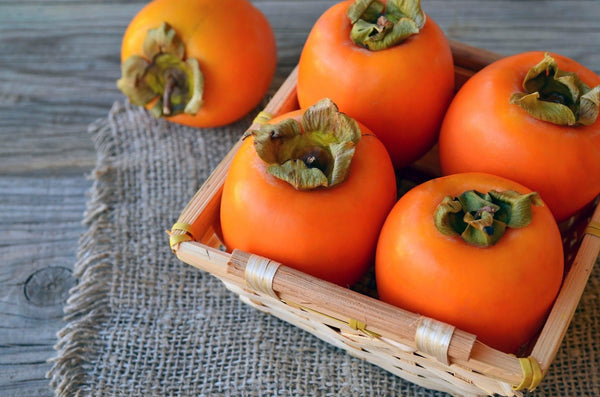
Jump to:
The persimmon is an orange edible fruit that grows on trees of the genus Diospyros, and its bright orange color is a recognizable sign of the arrival of autumn.
Persimmons can be described as having a somewhat “honey-like” sweet, mild, and rich taste, although depending on the type, they may have an astringent flavor. Their texture is somewhat similar to that of an apricot, and the skin is slightly tougher than that of an apple. There are many different types, but the most widely cultivated is the kaki persimmon.
The word Kaki has also been adopted in Japan to describe the fruit, although be careful when asking for it, as if you get the intonation wrong, you might end up with a plate of oysters (simply put, if you go up for the second syllable, it is persimmons, and if you go down, it is oysters). Kaki (as in persimmons) are in season from October and January, and although maybe not as fashionable as tropical fruit in the West, they are an important part of the Japanese diet.
In this article, we shall look at the primary production areas of Kaki in Japan, their history, and health benefits, and compare some different types of persimmons. We shall then look at ways they are eaten, and how to grow them, rounding off by looking at where to get them and how to choose a good Kaki.
Main Production Sites Of Persimmons In Japan

Kaki are produced over a wide area of Japan, from Tohoku to Kyushu. Wakayama Prefecture produces one-fifth of all Kaki produced in Japan and has been the largest producer of Kaki in Japan for 41 consecutive years. As of 2021, the second largest-producing prefecture in Japan was Nara Prefecture, followed by Fukuoka Prefecture, Gifu Prefecture, and Nagano Prefecture.
In all areas across Japan, a whopping total of just under 188,000 tons of Kaki were harvested, and, of these, 999 tons were exported. Although Japan is a major producer of persimmons, in terms of quantity, it pales in comparison to China where 75% of the world’s persimmons are produced.
A Brief History Of Persimmons in Japan
Although the origin of the Kaki is somewhat unclear, it is undoubtedly the case that they have a long history in Japan. Fossils of persimmons have been found in Tertiary deposits in Mizunami City, Gifu Prefecture, that were formed approximately 1.7 million years ago. Persimmon seeds have also been found in remains from the Jomon and Yayoi periods, suggesting that ancient people ate Kaki too. Ancient records suggest that they had already been bought and sold by the Nara period (710-794). In the 16th century, Portugal and other European countries began to import aspects of different cultures from around the world. Foreign nationals visiting Japan saw the Kaki for the first time and took back seedlings, causing Kaki to spread throughout the world.
Are Persimmons Good For You?

The answer to this question is a massive, unequivocal “Yes” There are five main nutritional elements in Kaki that make them good news for your body, as follows:
- Vitamins (particularly vitamins C and A)
- Potassium
- β-carotene
- Fiber
- Tannins
To take these in turn, Kaki are rich in vitamin C (approximately 20 times the amount of lemons). Ensuring a sufficient supply of this vitamin promises to aid in the prevention of colds, fatigue relief, the prevention of aging, and beautification of the skin.
Potassium, working in tandem with sodium, maintains cell osmolarity and our acid-base equilibrium, transmits nerve impulses, regulates cardiac and muscle function, and controls intracellular enzyme reactions.
β-carotene acts by being converted to vitamin A. β-carotene maintains the health of skin and mucous membranes. In addition to its function as vitamin A, β-carotene has been reported to have antioxidant and immuno-stimulating effects.
So, what about fiber? In addition to its intestinal regulating effects, including the prevention of constipation, many physiological functions have been revealed, such as suppressing elevated blood glucose levels and lowering blood cholesterol levels. Since most Japanese people are currently deficient in this food element, its active consumption is recommended.
Last, but not least, are the tannins. The astringency of Kaki is due to tannins, although sweet Kaki also contain tannins. They have antioxidant properties, so eating Kaki suppresses the increase of active oxygen, which is responsible for lifestyle-related diseases and aging. Tannins also help to break down alcohol, so it may be a good plan to eat Kaki after a heavy night out.
As always, you can get too much of a good thing. The over-consumption of tannins can lead to the formation of kidney stones. Additionally, although they are not particularly high in calories, one Kaki contains around 24 g of carbohydrates, so it is probably best to stick to one or two Kaki per day, especially if you are watching your weight.
What Different Types Of Persimmons Are There In Japan?

In Japan, Kaki can be broadly classified as either the astringent type or the non-astringent type. Although there are at least 17 varieties of persimmons, they all fall under one of these broader categories. An example of the astringent type is “Hachiya” and an example of the non-astringent (therefore, sweeter) type is “Fuyu”. You know that an astringent Kaki is ripe when it becomes soft and squishy, and the insides can be scooped out with a spoon. For the sweeter type, turning orange indicates that they are ripe and, when firm, they can be eaten like an apple, with which they share a similar texture.
In addition to eating them raw, as fruit, Kaki can be enjoyed in dried form, as a part of salads, or baked into bread and cookies.
Like the Japanese Kaki, there is also a wide variety of Korean persimmons, but the two most famous are the dan-gam and the ddeolbeun-gam, which are the Korean versions of the Hachiya and Fuyu Kaki, respectively. A major difference, however, is that traditionally Koreans will never heat their persimmons and always eat them raw.
Choosing A Good Kaki
When trying to buy the perfect Kaki, always choose fruit that is brightly colored, without any discolored areas. The skin should be firm and shiny, and the Kaki should be of uniform firmness, not too hard and not too soft. There should also not be any gap between the stalk and the fruit.
How To Store Kaki
Kaki will ripen and soften in about five days if stored at room temperature, so if you want to maintain their crispy texture, you will need to refrigerate them. The key is to prevent the stalk from drying out.
Take a piece of paper towel (or tissue paper) large enough to cover the stalk. Wet it with water and cover the stalk. Then wrap the Kaki in film and put it into a plastic bag, before placing it in the vegetable section of your refrigerator with the stalk face down. Alternatively, you can place the plastic bag inside a freezer bag and freeze it. In this case, it will keep for around six months.
Can You Grow Persimmons Yourself?

If you have green fingers and are feeling adventurous, you may like to try growing Kaki yourself. As long as you choose an area that meets certain criteria, you shouldn’t face too many difficulties.
Firstly, Kaki trees are susceptible to drying out, so the soil should be water retentive, but they will also suffer if the area is waterlogged, so the soil must also have good drainage. The area in which you plant them should have full access to the sun but also be protected from strong winds that might damage the tree. The best time to plant is in the dormant season from November to March.
Once planted, they do not require a lot of care, and they only need to be watered when the surrounding soil dries out. You will need some patience, though, as it will take four to five years for the Kaki tree to bear fruit for the first time.
Kaki Persimmon Products And Where To Get Them
Kaki as a raw fruit are readily available in the fruit and vegetable section of supermarkets as well as greengrocer’s. As already mentioned, Kaki are also a popular addition to bread, pastries, cookies, and even mochi. A very accessible way to enjoy the undoubted health benefits of Kaki is as a dried fruit, or Hoshigaki, in which the persimmons are dehydrated and massaged by hand. You can get more information about Hoshigaki in this article and find this and other healthy Japanese snacks on the Japanese Taste website.
Kaki -The Healthy And Delicious Japanese Persimmon

As previously mentioned, the sight of the vibrant orange Kaki fruit is recognized throughout Japan as a welcome sign of the coming of autumn. It is a delicious fruit that can be eaten raw or added to confectionery, as well as being available in dried form, as Hoshigaki.
When eaten in moderation, Kaki have a lot of nutritional benefits as well, so are definitely a fruit that is worth incorporating into your diet.
Are you a fan of the Japanese persimmon? Let us know in the comments.


0 comments